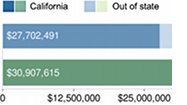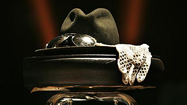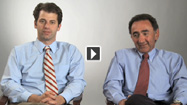Teacher responses to the 2010 release
The following is a list of teacher responses to their "value-added" ratings during the intial release in 2010. See the most recent responses »
The Times gave LAUSD elementary school teachers rated in this database the opportunity to preview their value-added evaluations and publicly respond. Some issues raised by teachers may be addressed in the FAQ. Teachers who have not commented may do so by contacting The Times.
|
|
 Delicious
Delicious
|
 Digg
Digg
|
 Facebook
Facebook
|
 Twitter
Twitter
|





For anyone reading the VAM rating put on me by the L.A. Times, please keep these things in mind:
1. I used to teach severely emotionally disturbed children (in a special education class) at this school, which is located in South-Central Los Angeles. I worked with some who had committed crimes as minors. As a result, since making the switch to teaching regular ed., I have regularly been given students who pose serious behavioral challenges, year after year. Men such as myself often receive the most unruly students as there is a prevailing notion that we can handle them. As a result, my classes have been chronically disrupted. I have had students who have brought weapons to school, committed sexual assault, and have otherwise been violent towards other students and sometimes towards me. Disruptive behavior has been a constant issue at this school, for which there has been no adequate remedy. Suspensions and occasional expulsions are only partially effective in dealing with these problems. When an inordinate amount of time is spent during each school day quelling conflicts among students, valuable instructional time is lost.
2. The CST data from the years in which I taught 2nd grade are irrelevant to this VAM rating. The grade level info for my name/data implies that this data was also taken into account, going back several years. However, since the VAM relies on comparing students' CST scores to their scores from previous years of testing, there is no comparison to be made for 2nd graders. Why is this? This is because first graders do not take the CST. Therefore, it is misleading to suggest that CST scores from the years in which I taught 2nd grade is somehow related to the "average" rating I received. It is not relevant. If my 2nd grade students scored very well on the CSTs, (as a result of my working very hard), then my rating as a teacher could not benefit from this at all.
3. The majority of the students I have taught at this school have been English Language Learners who have limited English proficiency. Many are recent immigrants or the children of recent immigrants (typically from Mexico or Central America). After being in the U.S. for only one year, these same students are subjected to being tested on the CST in English. It is therefore not suprising that many of them fail to perform well when they are still trying to learn the basics of the language. Blaming and scapegoating teachers for a lack of academic performance on the part of their students is a very narrow and misguided approach toward solving a complicated problem. One thing that WOULD help our students is parental literacy and involvement in the educational process at home.
4. The CST data that I have been shown at my school for the 4th and 3rd grade students I have taught indicate trends which are the OPPOSITE of what is being shown above. Put simply, my 4th (and 3rd) grade students have typically fared BETTER in Reading/Language Arts than they have on the Math portion of the CST. For example, 78% of my 4th grade students from 2009-2010 scored higher on the Reading/Language Arts portion of the CST in 4th grade as compared to their 3rd grade scores. 12% went down. In Math, 61% scored either higher or the same as in 3rd grade, while 39% scored worse. While this data was not included in the VAM for this database, it is consistent with the trends from previous years, which show that my students have typically improved more in Reading/Language Arts than they have in Math. Yet, I have been labeled as "Less effective than average in English" - which leads one to wonder the following: either that the "average" gains in Reading/Language Arts across the district must be very impressive among my peers, or that this methodology for rating teachers is unreliable.
5. I am also required to teach social studies, science, English Language Development (since most of my students are not native English speakers), art, music, health, and physical education. Teachers do not spend all of their time teaching reading and math. These other subjects are not assessed on the CST. Any benefits that I may have imparted to my students in these subjects is not taken into account with the VAM.
6. I have 34 students in my class, and a teaching assistant for 25-minutes per day. Those who teach 3rd grade (or lower grades) typically have about 20 students (give or take a few) and have teaching assistants for longer periods of time. It is more difficult to ensure the proficiency of each student when class sizes are larger, and assistance is reduced. I'm only one person. If we as a society want to solve the "achievement gap," then hire more people to work together to educate our children. I cannot give the individual attention that I would like to give to each student each day.
7. Some teachers with higher rankings of effectiveness (e.g. 'more effective' or 'most effective') are either: a) great teachers doing a wonderful job who are able to reach most of the students in their classes, or b) cheaters who help to supply the answers to their students during the CST in an effort to make themselves look effective.
October 12, 2010 at 5:46 p.m.
After forty-five (45) years of teaching for LAUSD, this is not an accurate picture of my teaching.
1. This rating is based on one per cent (1%) of my teaching career.
2. It only includes twelve per cent (12%) of the students I taught.
3. Over one thousand, two hundred (1,200) students are not included.
4. I am retired and there is nothing that can be done for future
educational years.
5. During my last two years of teaching, a new "rookie" principal was
assigned to Los Feliz. She did not allow me to use my previously
successful methods.
Perhaps your next data base could show schools with their API scores
and name the principals for each school.
It could look something like this.
API-LOS FELIZ ELEMENTARY SCHOOL
Year API Change Principal
2002 701 (N. A.) Castaneda
2003 753 +52 Castaneda
2004 775 +22 Castaneda
2005 788 +23 Castaneda
2006 779 -9 Pilkington
2007 770 -9 Pilkington
October 8, 2010 at 1:53 p.m.
katie i am so proud of you and your accomplishments but most of all i know the person that is teaching these lucky young students their success will be because of you and your love of teaching and concern for their futures congratulations amazing bari
September 29, 2010 at 8:18 p.m.
As I was rated 'most effective' in the recent LA Times value-added teacher ratings report, I feel that I can respond to the project without being accused of a sour grape attitude. I think the best way to approach the absurdity of the LA Times study is to offer an analogy of how 'statistics' can be misconstrued... and consequently cause irreversible damage due to the sensationalist manner in which they were presented. A few years after our school reopened, a very well educated parent raised the concern we were not doing enough to make sure our gifted students stayed at our school. She talked with other parents, and finally it was necessary to bring the issue to the table at our monthly school meeting. Our cluster supervisor also attended as did I due to the fact I was the coordinator of the gifted and talented program at that time. The parent started the conversation by waving a paper in the air and stating, "Our September report shows that fifteen 'gifted' children have already left the school!" With as serious a face as I could muster under the circumstances, I replied, "I am so sorry about that but those children graduated from fifth grade in June, and that is why they left." Although the statistics had been explained, to this day parents still question our programs based on those original inquiries. My point here is that even highly educated people are often led astray by 'statistics'. Statistics give numbers and trends, but do not include the human element. The Times has managed to demoralize outstanding teachers by branding them, and as a caveat in the FAQ section stating that their findings should only be partially counted in an overall teacher evaluation. How many people stopped to read that, and even if they did, their judgment has now been clouded with the, "Well if they are not good in English and Math, how could they be good at anything else?" Children are not statistics. Children are our living, breathing future. They need to be inspired to be great scientists and thinkers. Think about some of our great men and women in history who had learning disabilities, or who thought miles beyond the 'simplicity' of English and Math! Their teachers probably would not have passed the value-added test, but they inspired these people and encouraged them to move forward on their ideas. Think about it LA Times, before you go tampering with our future again.
September 23, 2010 at 9:36 p.m.
Dear Reader,
The Times has asked for my opinion of these scores. I respect your intelligence enough to reply.
Do these scores accurately evaluate the test results obtained by my students? Pretty much so. But they do not reflect the full rich curriculum I have provided children over the past 28 years of service to the district. I am a very competent teacher and I have proven myself by passing and renewing my National Board certification. I have been an NBC teacher since 2000.
My classroom addresses the needs of highly gifted students in an urban, socio-economically less advantaged neighborhood. The children in my room receive instruction in all of the curricular areas as well as enrichment in Research and Technology, Visual Arts, and Theater. My goal is to contribute to the creation of thinkers. My children are college bound, critical thinking, creative young people who will add much to society and will become tomorrows leaders.
I am not threatened by the release of these scores but I am very disappointed, for they are not a reflection of all we do for children in our school. And knowing them will not help you chose a better teacher or school. Knowing the scores helps us evaluate our own work. They should be used for reflection and remediation but not for public ridicule.
The scores reflect only one point, how much growth, read that "points" did a child improve from one year’s test to another. Now picture this scenario.
Your child masters second grade skills, earns near perfect scores on the state test. The next year in third grade, the test is harder, the curriculum has grown of course but now the child takes the test without oral teacher support. Your child passes, she is Advanced! However, she dropped 2 points or 5 or even 10. And every child in her room has done the same. The third grade teacher, an exceptional engaged teacher, displays scores in the Least Effective range. Her children all passed the test, but the points did not grow, they consistently dropped, across the board.
What matters? The rich, diverse curriculum the children received? Their passing tests? Or the point drop between the grade levels?
The child moves on to fourth grade, in this class she masters the curriculum and scores near perfect again on the state test. In several subtests she scores 100% in math areas. On to fifth grade, she is in my room, is taught the entire standards based curriculum, learns how to create her own PowerPoint displays, researches an area of interest to her that she chose herself (maybe Black Colleges, Fringed Lizards, Ancient Languages), and scores solidly on the state test but again has dropped several points in the Math section of the test. She still understands the curriculum and has demonstrated at the least Proficiency in all areas. Does the score affect her future school plans? No, she proceeds to the middle school of her parent’s choice.
Does her score affect my value- added rating? Yes, my math score drops to the effective range. Do I care? No, I have spent nearly 180 days contributing to the growth and maturity of a fine young woman who had a variety and wealth of learning experiences in my classroom.
September 20, 2010 at 8:09 a.m.
The years that I taught 3rd grade were for Bilingual Waiver classes. Many of the students in those classes were taught primarily in Spanish, along with instruction in ESL. The students had various degrees of English language proficiency, and since Spanish was the dominant language for all of those students, the expectations were not that high for the CST scores for those students, since standardized tests were largely discounted as an assessment at that time. Also, it was expected that these bilingual students would perform much better on the Spanish counterpart of the CST -- the "Aprenda" test. These scores were not reported in the L.A Times database, nor were these tests even mentioned in the LA Times report:
http://www.cde.ca.gov/ta/tg/sr/qandadplt08.asp
Standardized testing is a useful tool to get an idea of how well students are mastering various topics. Scores from standardized tests should be used to help teachers focus on those skills in which students are coming up short. I'm not sure of the value of publicly labeling teachers as less or least effective at raising test scores, since the parents don't generally get to choose the teacher, any more than the teachers get to choose which students will be in their classroom. It is also worth noting that the gifted students and the ones with serious behavior problems have not been evenly distributed. This kind of public rating will most likely serve to reinforce those kinds of placements. And yes, these types of students (especially the latter) do affect the learning environment and performance of classrooms as a whole.
I'd bet that there are many "less effective" teachers who have seen their students make significant progress in writing and other areas that aren't necessarily measured on the CST tests. But the message we're getting from the LA Times public rating scheme is that these test scores are paramount. Teachers might feel compelled to do whatever it takes, by any means necessary, to get on the upper half of that Value-added Normal Curve. But the normal distribution of scores requires that half of the teachers fall below the 50th percentile or Statistical Mean Average. This means that when the Value-added Ratings of some teachers go up, it follows that others will be going down . . .
September 16, 2010 at 9:15 a.m.
In a stunning pre-emption of the LAUSD, UTLA, Sacramento and, perhaps even the Federal government, the LA Times seems to have relinquished its title to the fourth estate by opting to create controversy rather than to report it.
Ineptly using their California Schools Guide, an egregiously flawed database, under the pretext of public disclosure, they have distorted data and manufactured a climate of distrust and suspicion that has suffused our educational community.
Teetering on the edge of libel and timed to coincide with the start of the traditional school year, one can only wonder - “What were they thinking?” What is the purpose of these posts? Does the Times consider their pie charts and pronouncements to be a public service?
There is already a Uniform Complaint Policy in place to address parental concerns. It is sad to see the defensive posture being adopted by so many excellent teachers because of these faulty interpretations, but you can’t unring a bell. Freedom of the press doesn’t mean whipping parents into a frenzy and then running for cover behind the First Amendment.
Being anti-teacher is also being anti-children. Have not students been bludgeoned enough by budget cuts? Have they not lost enough teachers and programs due to monetary constraints? As long as the Times has abdicated its role as a newspaper, it should be relegated to the bottom of the birdcage.
Gretchen Garrett
5/6 Grade Teacher
Valley View Elementary School
September 15, 2010 at 8:57 p.m.
This is such a tiny piece of a very big pie to evaluate efficacy!
September 15, 2010 at 4:09 p.m.
Throughout my career, I have received feedback about my teaching methods and effectiveness. I have used this information to refine my teaching practices. I will use my "value added" rating to continue to do so.
While I am not convinced that the value added model is entirely fair, it is a good starting point to begin to talk about teacher effectiveness. I don't think it should be the only factor that is measured when looking at a teacher, but it can give a place for the dialogue to start. Test scores should not be the entire focus of education, but they are important and educators are charged with teaching the standards that are tested.
I know that I am an effective educator, not based on this value added model, but on countless comments from parents, administrators, colleagues, and students. I have seen growth in the test scores of my students from year to year (some going up 2 levels at a time). I have been observed many times, used a model for other teachers often, and have led staff developments. I welcome anyone who wants to come and observe my practice. I am proud of my profession and my efforts with my students.
September 14, 2010 at 8:08 p.m.
The LA Times and LAUSD have collaboratively demoralized and discouraged many honest and dedicated teachers. Posting the teacher effectiveness scores on the internet was disastrous and has irrevocably destroyed the dignity, self-respect , reputations, and even some careers of a myriad of remarkable, compassionate teachers who, for many years, have gone above and beyond the ringing of the last bell each school day in order to serve both their students and their school. It is especially insidious because the data was flawed in that the data collection was inconsistent and incomplete. The data analysis completely ignored pertinent factors that contribute to lower achievement such as the gross inequities in classrooms within each school .
In my case, I am apparently a “mediocre” teacher. I teach gifted and high achieving students and in addition to teaching the required standards, I invest much time planning a thoughtful, stimulating, balanced curriculum that supplements, challenges, and enriches my students. They are exposed to many areas of studies through differentiated instruction, and I can say that I am proud of my efforts and the benefits derived by my students. It has always been my goal to instill the love of learning in every student and to develop lifelong learners. For, without the love of learning, they can never reach their full potential.
September 12, 2010 at 2:44 p.m.